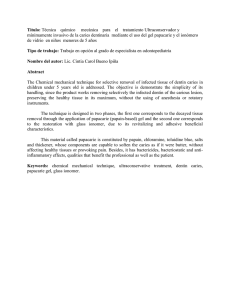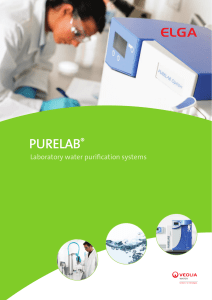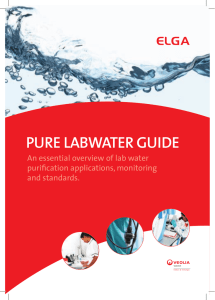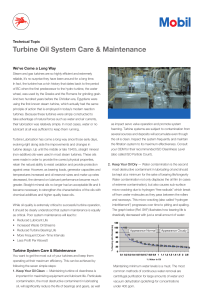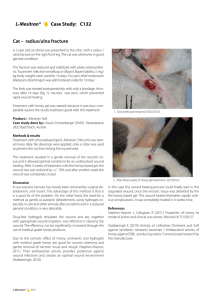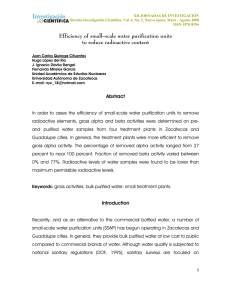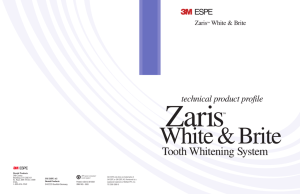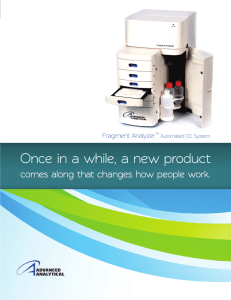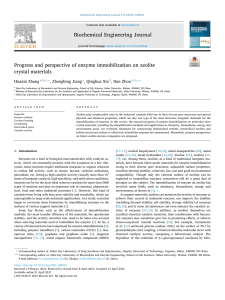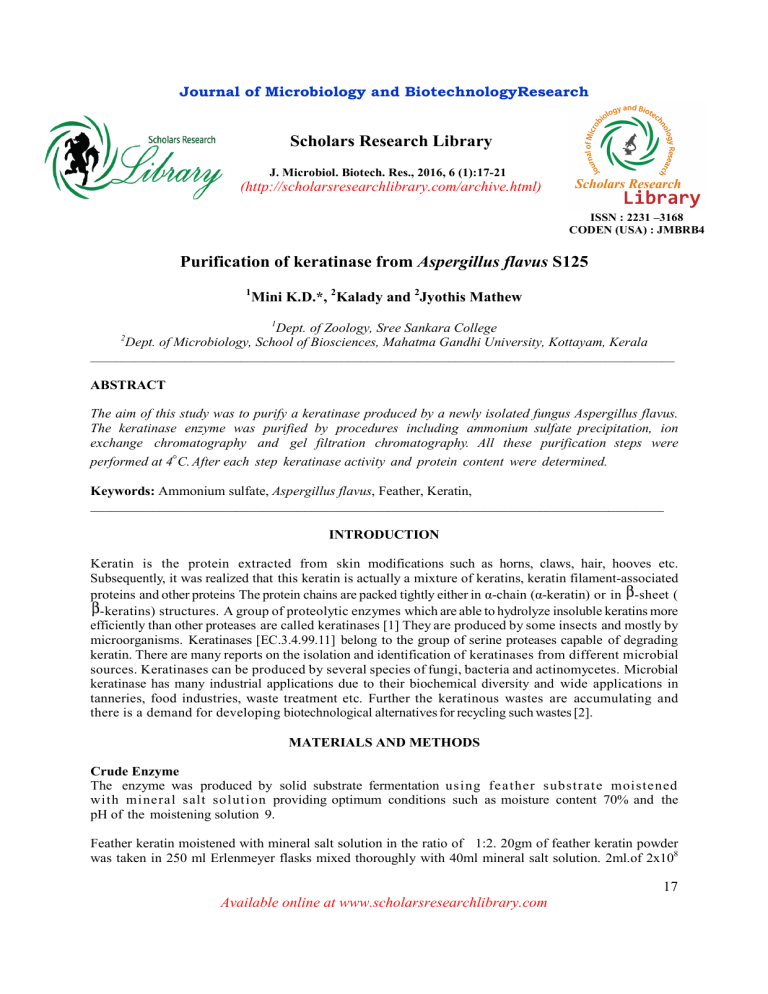
Journal of Microbiology and BiotechnologyResearch Scholars Research Library J. Microbiol. Biotech. Res., 2016, 6 (1):17-21 (http://scholarsresearchlibrary.com/archive.html) ISSN : 2231 –3168 CODEN (USA) : JMBRB4 Purification of keratinase from Aspergillus flavus S125 1 Mini K.D.*, 2Kalady and 2Jyothis Mathew 1 Dept. of Zoology, Sree Sankara College Dept. of Microbiology, School of Biosciences, Mahatma Gandhi University, Kottayam, Kerala 2 _____________________________________________________________________________________________ ABSTRACT The aim of this study was to purify a keratinase produced by a newly isolated fungus Aspergillus flavus. The keratinase enzyme was purified by procedures including ammonium sulfate precipitation, ion exchange chromatography and gel filtration chromatography. All these purification steps were performed at 4◦C. After each step keratinase activity and protein content were determined. Keywords: Ammonium sulfate, Aspergillus flavus, Feather, Keratin, ___________________________________________________________________________________ INTRODUCTION Keratin is the protein extracted from skin modifications such as horns, claws, hair, hooves etc. Subsequently, it was realized that this keratin is actually a mixture of keratins, keratin filament-associated proteins and other proteins The protein chains are packed tightly either in α-chain (α-keratin) or in -sheet ( -keratins) structures. A group of proteolytic enzymes which are able to hydrolyze insoluble keratins more efficiently than other proteases are called keratinases [1] They are produced by some insects and mostly by microorganisms. Keratinases [EC.3.4.99.11] belong to the group of serine proteases capable of degrading keratin. There are many reports on the isolation and identification of keratinases from different microbial sources. Keratinases can be produced by several species of fungi, bacteria and actinomycetes. Microbial keratinase has many industrial applications due to their biochemical diversity and wide applications in tanneries, food industries, waste treatment etc. Further the keratinous wastes are accumulating and there is a demand for developing biotechnological alternatives for recycling such wastes [2]. MATERIALS AND METHODS Crude Enzyme The enzyme was produced by solid substrate fermentation using feather substrat e moistened with mineral salt solut ion providing optimum conditions such as moisture content 70% and the pH of the moistening solution 9. Feather keratin moistened with mineral salt solution in the ratio of 1:2. 20gm of feather keratin powder was taken in 250 ml Erlenmeyer flasks mixed thoroughly with 40ml mineral salt solution. 2ml.of 2x108 17 Available online at www.scholarsresearchlibrary.com Mini K D et al J. Microbiol. Biotech. Res., 2016, 6 (1):17-21 ______________________________________________________________________________ spore suspension of the fungus Aspergillus flavus S125 was inoculated into the medium and kept at 55˚C and incubated for 4 days. Extraction of crude enzyme The culture filtrate extracted as described under chapter 3 section B was used as the crude enzyme. Purification of the enzyme The keratinase enzyme was purified by procedures including ammonium sulfate precipitation, ion exchange chromatography and gel filtration chromatography. All these purification steps were performed at 4◦C. After each step keratinase activity and protein content were determined. Ammonium sulfate precipitation Ammonium sulfate was added into the culture supernatant and the precipitate obtained at 75% saturation was collected by centrifugation at 10000 rpm for 20 min. The precipitate was dissolved in 0.01 M potassium phosphate buffer of pH (7.5) and was dialyzed against the same buffer. Dialysis Activation of dialysis tube 1mM EDTA was dissolved in 100 mL of 2% Na2CO3 (solution ‘a’). Solution ‘b’ was prepared by dissolving 1 mM EDTA in 100 mL distilled water. The dialysis bag was immersed in the boiling solution 'a’ for 20 mines. It was then soaked in hot water to remove Na2CO3. After that the tubes were immersed in boiling solution of ‘b’ for 10 min. The activated dialysis tube was kept immersed in solution ‘b’ in the refrigerator. Dialysis The activated dialysis tube (cut off value 12 kDa) was tied at its one end and filled with ammonium sulfate fraction without trapping any air bubble. It was then tied at its upper end and suspended in a beaker containing 0.01 M phosphate buffer of pH 7.5 and kept overnight at 4◦C. The buffer solution was changed regularly during dialysis. The concentrated dialysate was collected, pooled and kept for ion exchange chromatography. Purification using DEAE cellulose Column Activated DEAE cellulose was carefully packed in a column of size 2.5 X 7 cm without trapping any air bubble. Sample was applied to the DEAE cellulose column, pre equilibrated with 10mMphosphate buffer (pH7.5). The enzyme elution was performed by gradient elution technique using NaCl gradient of 0 to 0.5 M in 20mM citrate - phosphate buffer (pH 7.5) at a flow rate of 24 mL/h. Fractions of 5 mL were collected and was assayed for enz yme activity. Protein concentration was measured at 280 nm. The active fractions were pooled and dialyzed against 50 mM sodium acetate buffer (pH 4.5). Gel filtration chromatography Sephadex G-100 was packed in a column of size 1.6X60 cm without any air bubble and it was pre equilibrated with 50 mM sodium acetate buffer (pH 4.5) before the dialysate was applied. Elution of the enzyme was carried out with 50 mM sodium acetate (pH 4.5) at a flow rate of 15 mL/h. 5 mL fractions were collected and each fraction of enzyme solution was assayed for enzyme activity and protein content was measured. The active fractions were pooled and dialyzed against 0.01 M phosphate buffer of pH (7.5). Electrophoretic methods Samples obtained at various stages of purification were run on 10 % SDS– PAGE gel (appendix) according to the method of [3]. Gel was run at pH 8.8 at a constant current of 2mA per gel as for slab gel 18 Available online at www.scholarsresearchlibrary.com Mini K D et al J. Microbiol. Biotech. Res., 2016, 6 (1):17-21 ______________________________________________________________________________ electrophoresis. Gel was stained with 1% Coomassie Brilliant Blue R-250 in 45% methanol-10% acetic acid solution for 4 h and destained in the same solvents for 4 h. RESULTS Purification of keratinase The summary of purification is given in Table 4.1 Fig. 5.1 Chromatogram of the keratinase on DEAE cellulose ion exchange chromatography Fig. 5.2 Chromatogram of the keratinase on a Sephadex G- 100 gel filtration chro- matography 19 Available online at www.scholarsresearchlibrary.com Mini K D et al J. Microbiol. Biotech. Res., 2016, 6 (1):17-21 ______________________________________________________________________________ In the chromatogram the keratinase activity could be seen in a single peak. The peak was eluted with 20 mM citrate-phosphate buffer (pH 5.5) containing 0.2-0.5 M NaCl. In the gel filtration, both keratinase and protein were observed in single peak. Table 1 Summary of purification Total protein Total keratinasa (mg) activity(U) (mg) (u) Step Step Crude extract (NH4)2SO4 precipitation DEAE-cellulose Sephadex G 100 2810 1292 286 98 7489 6826 4588 3240 Specific activity U/mg (u/mg protein) 2.66 5.28 16.04 33.06 Purification fold Yield (%) 1 1.98 6.03 12.42 100 91.14 61.26 43.26 The keratinase was precipitated at 75% saturation of ammonium sulphate. The ammonium sulfate precipitated and dialyzed protein was measured as 1292 mg with specific activity of 5.28 u/mg with purification fold 1.89. The semi purified enzyme was further purified through the DEAE cellulose column. Keratinase activity was detected in the 0.2 to 0.5 M NaCl step-elution fraction. The elution profile keratinase from DEAE cellulose column is shown in figure 6.1. The active fractions were pooled, and the pooled fractions showed 6.03 fold purification with a specific activity of 16.04 U/ mg and filtration. The elution profile of gel filtration is shown in figure 6.2 The specific activity of the purified 61.26% recovery of protein. The keratinase was further purified by Sephadex G-100 gel enzyme was 33.06 U/mg protein and the purification fold was 12.42. Lane - 1 Lane - 2 Lane - 3 SDS-PAGE analysis of keratinase purified from Aspergillus flavus S125 Lane 1 - Molecular weight markers (Chromous Biotech PMB 01) Lane 2- Sample after Sephadex G-100 chromatography Lane 3- Eluate from Ion exchange purified proteins 20 Available online at www.scholarsresearchlibrary.com Mini K D et al J. Microbiol. Biotech. Res., 2016, 6 (1):17-21 ______________________________________________________________________________ The purified enzyme on SDS PAGE gave a single band near 35 kDa indicating the homogeneity of the preparation. (Plate 5.1) DISCUSSION Keratinase enzyme was produced by the fungus Aspergillus flavus S125 by solid substrate fermentation was purified from the enzyme extract of feather keratin by the procedures like ammonium sulphate precipitation, ion exchange chromatography and gel filtration. When the purified enzyme was subjected to PAGE, the protein was found migrating as a single band with keratinase activity indicating the homogeneity of the preparation. Recovery of enzyme was 43.26%. As a result of purification, 12.42 fold increases in the specific activity was recorded. It has been reported that the purification of keratinase from the culture medium of Scopulariopsis brevicaulis yielded a purified keratinase fraction having an overall purification factor of 10-fold [4]. The final product had a specific activity of about 80 U/mg with the yield of 22.44%. [5] purified keratinase from Aspergillus flavus strain K-03 with 11 fold purification. [6] purified keratinase from Aspergillus flavipes with a specific activity of 55.5 U/mg protein and of about 2.67 purification fold over the crude enzyme preparation. Similar purification protocols were used for keratinase from bacterial species such as Bacillus licheniformis [7], Chrysobacterium sp. Kr6 [8], [9] and Streptomyces sp. [10]. REFERENCES [1] Onifade, A.A., Al-Sane, N.A., Al-Musallam, A.A. & Al-Zarban, S., Bioresour. Technol. 1998, 66:1– 11. [2] Gupta R, Ramnani P.,.Appl Microbiol Biotechnol. 2006,;70 (1):21–33. [3] Laemmli UK.,. Nature. 1970, ;227(5259):680–685 [4] Girija, Sankar, G., Satya, Lakshmi, S., Prabhakar, T., & Kamala, Kumari, P.V., Int. J. Pharm. Sci. Rev. Res., 2014, 24(2), 257-262. [5] Kim, J. D., Mycobiology. 2007, 35(4), 219-225 [6] Yassin, M., El-Ayouty.. African Journal of Biotechnology. 2012,11(9). 2313-2319 [7] Lin, X., Lee, C. G., Casale, E. S., & Shih, J. C.. Applied and Environmental Microbiology, 1992 58(10), 3271-3275 [8] Riffel, A., Lucas, F., Heeb, P., & Brandelli, A.. Archives of Microbiology, 2003, 179(4), 258-265 [9] Riffel, A., Brandelli, A., Bellato, C.M., Souza, G.H.M., Eberlin, M.N., Flavio, C. & Tavares, A.. Biotechnology. 2007 128, 693–703. [10] Boeckle, B., Galunsky, B., & Mueller, R.. Applied and Environmental Microbiology. 1995, 61(10), 3705-3710 21 Available online at www.scholarsresearchlibrary.com
